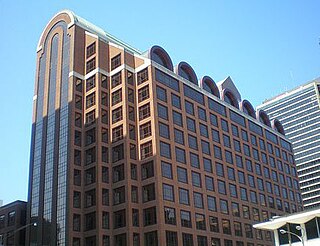Related Research Articles

Lehman Brothers Inc. was an American global financial services firm founded in 1850. Before filing for bankruptcy in 2008, Lehman was the fourth-largest investment bank in the United States, with about 25,000 employees worldwide. It was doing business in investment banking, equity, fixed-income and derivatives sales and trading, research, investment management, private equity, and private banking. Lehman was operational for 158 years from its founding in 1850 until 2008.
Kuhn, Loeb & Co. was an American multinational investment bank founded in 1867 by Abraham Kuhn and his brother-in-law Solomon Loeb. Under the leadership of Jacob H. Schiff, Loeb's son-in-law, it grew to be one of the most influential investment banks in the late 19th and early 20th centuries, financing America's expanding railways and growth companies, including Western Union and Westinghouse, and thereby becoming the principal rival of J.P. Morgan & Co.

Nomura Securities Co., Ltd. is a Japanese financial services company and a wholly owned subsidiary of Nomura Holdings, Inc. (NHI), which forms part of the Nomura Group. It plays a central role in the securities business, the group's core business. Nomura is a financial services group and global investment bank. Based in Tokyo, Japan, with regional headquarters in Hong Kong, London, and New York, Nomura employs about 26,000 staff worldwide; it is known as Nomura Securities International in the US, and Nomura International plc. in EMEA. It operates through five business divisions: retail, global markets, investment banking, merchant banking, and asset management.
Dean Witter Reynolds was an American stock brokerage and securities firm catering to a variety of clients. Prior to the company's acquisition, it was among the largest firms in the securities industry with over 9,000 account executives and was among the largest members of the New York Stock Exchange. The company served over 3.2 million clients primarily in the U.S. Dean Witter provided debt and equity underwriting and brokerage as mutual funds and other saving and investment products for individual investors. The company's asset management arm, Dean Witter InterCapital, with total assets of $90.0 billion prior to the acquisition, was one of the largest asset management operations in the U.S.
Jefferies Group LLC is an American multinational independent investment bank and financial services company that is headquartered in New York City. The firm provides clients with capital markets and financial advisory services, institutional brokerage, securities research, and asset management. This includes mergers and acquisitions, restructuring, and other financial advisory services. The Capital Markets segment also includes its securities trading and investment banking activities.

Bache & Company was a securities firm that provided stock brokerage and investment banking services. The firm, which was founded in 1879, was based in New York, New York.

Stifel Financial Corp. is an American multinational independent investment bank and financial services company created under the Stifel name in July 1983 and listed on the New York Stock Exchange on November 24, 1986. Its predecessor company was founded in 1890 as the Altheimer and Rawlings Investment Company and is headquartered in downtown St. Louis, Missouri.

Oppenheimer Holdings Inc. is an American multinational independent investment bank and financial services company offering investment banking, financial advisory services, capital markets services, asset management, wealth management, and related products and services worldwide. The company, which once occupied the One World Financial Center building in Manhattan, now bases its operations at 85 Broad Street in New York City.
L.F. Rothschild was a merchant and investment banking firm based in the United States and founded in 1899. The firm collapsed following the 1987 stock market crash.

Shearson was the name of a series of investment banking and retail brokerage firms from 1902 until 1994, named for Edward Shearson and the firm he founded, Shearson Hammill & Co. Among Shearson's most notable incarnations were Shearson / American Express, Shearson Lehman / American Express, Shearson Lehman Brothers, Shearson Lehman Hutton and finally Smith Barney Shearson.

Shearson, Hammill & Co. was a Wall Street brokerage and investment banking firm founded in 1902 by Edward Shearson and Caleb Wild Hammill. The firm originally built its business as a stock broker as well as a broker of various commodities, particularly grain and cotton. The firm was a member of the New York Stock Exchange, the Chicago Stock Exchange and the Chicago Mercantile Exchange.
Loeb, Rhoades & Co. was a Wall Street brokerage firm founded in 1931 and acquired in 1979 by Sanford I. Weill's Shearson Hayden Stone. Although the firm would operate as Shearson Loeb Rhoades for two years, the firm would ultimately be acquired in 1981 by American Express to form Shearson/American Express and three years later Shearson Lehman/American Express.
Cogan, Berlind, Weill & Levitt, originally Carter, Berlind, Potoma & Weill, was an American investment banking and brokerage firm founded in 1960 and acquired by American Express in 1981. In its two decades as an independent firm, Cogan, Berlind, Weill & Levitt served as a vehicle for the rollup of more than a dozen brokerage and securities firms led by Sanford I. Weill that culminated in the formation of Shearson Loeb Rhoades.
Hornblower & Weeks was an investment banking and brokerage firm founded by Henry Hornblower and John W. Weeks in 1888. At its peak in the late 1970s, Hornblower ranked eighth among member firms of the New York Stock Exchange in number of retail offices, with 93 retail sales offices located in the United States and Europe.
Wertheim & Co. was an investment firm founded in 1927 by Maurice Wertheim and Joseph Klingenstein, who met when they worked together at Hallgarten & Company. The firm engaged primarily in the merchant-banking business; it invested from its formation until the deaths of Wertheim and one of his senior partners in 1950 and 1952 respectively.
Gruntal & Co. was a boutique investment banking and brokerage firm based in New York City. Prior to its acquisition in 2002, the firm was among the oldest independent investment banking houses in the U.S. The firm was founded as Sternberger & Fuld in 1880 by Maurice Sternberger, who partnered with Ludwig Fuld. Sternberger bought a seat on the New York Stock Exchange in 1881 for $20,000. They were joined in 1884 by a third partner, Samuel Sinn, and the firm became Sternberger, Fuld & Sinn, with an office at 52 Broadway in Lower Manhattan.

Dominick and Dickerman LLC is an investment and merchant banking firm headquartered in New York City. It also has offices in Basel, Switzerland. From 1899 to 2015, the firm was known as Dominick and Dominick but after selling off its wealth management business, the firm reverted to its original name, Dominick and Dickerman.
Harvey Fisk & Sons was formed in 1885 from the firm Fisk & Hatch that dated back to 1862. The firm was prominent in railroad financing and financed the American Locomotive Company and the Hudson & Manhattan Railroad.

Alfred Samuel Heidelbach was an American banker and stock broker.
Donald Sigmund Stralem (1903-1976) was an American investment banker and philanthropist. Stralem worked as a partner in Hallgarten & Company and then served as chairman of Stralem and Company, an international investment bank that he founded in 1967. He also co-founded the North Shore Hospital in Manhasset, New York.
References
- ↑ Bankers magazine, Volume 61, 1900, page 944
- ↑ American Jewish history: the colonial and early national periods ..., Volume 2 By Jeffrey S. Gurock, American Jewish Historical Society page 71,
- ↑ The history of foreign investment in the United States to 1914 By Mira Wilkins
- ↑ History of Hallgarten & Co 1850-1950, unpublished
- ↑ New York Times January 10, 1884
- 1 2 Our Crowd by Stephen Birmingham, Harper & Row 1967 pgs 9-11
- ↑ London, Christie's Catalogue, 13.XII.1984,
- ↑ UPenn Alumni Obituaries, 2006
- ↑ Wilkins, Mira (2004). The History of Foreign Investment in the United States to 1914 . Cambridge: Harvard University Press. p. 869. ISBN 0-674-01308-5.
- ↑ Michie, Ranald C. (1999). The London Stock Exchange: A History . Oxford: Oxford University Press. p. 469. ISBN 0-19-924255-0.
- ↑ Mergers and acquisitions: issues from the mid-century merger wave By Michael Keenan, Lawrence J. White, pg 307-310
- ↑ PR Newswire Article date:November 9, 1987
- ↑ The Boston Globe (Boston, MA) Article dated February 2, 1988
- ↑ Thinking about political corruption by Peter DeLeon. Published by M.E. Sharpe, 1993